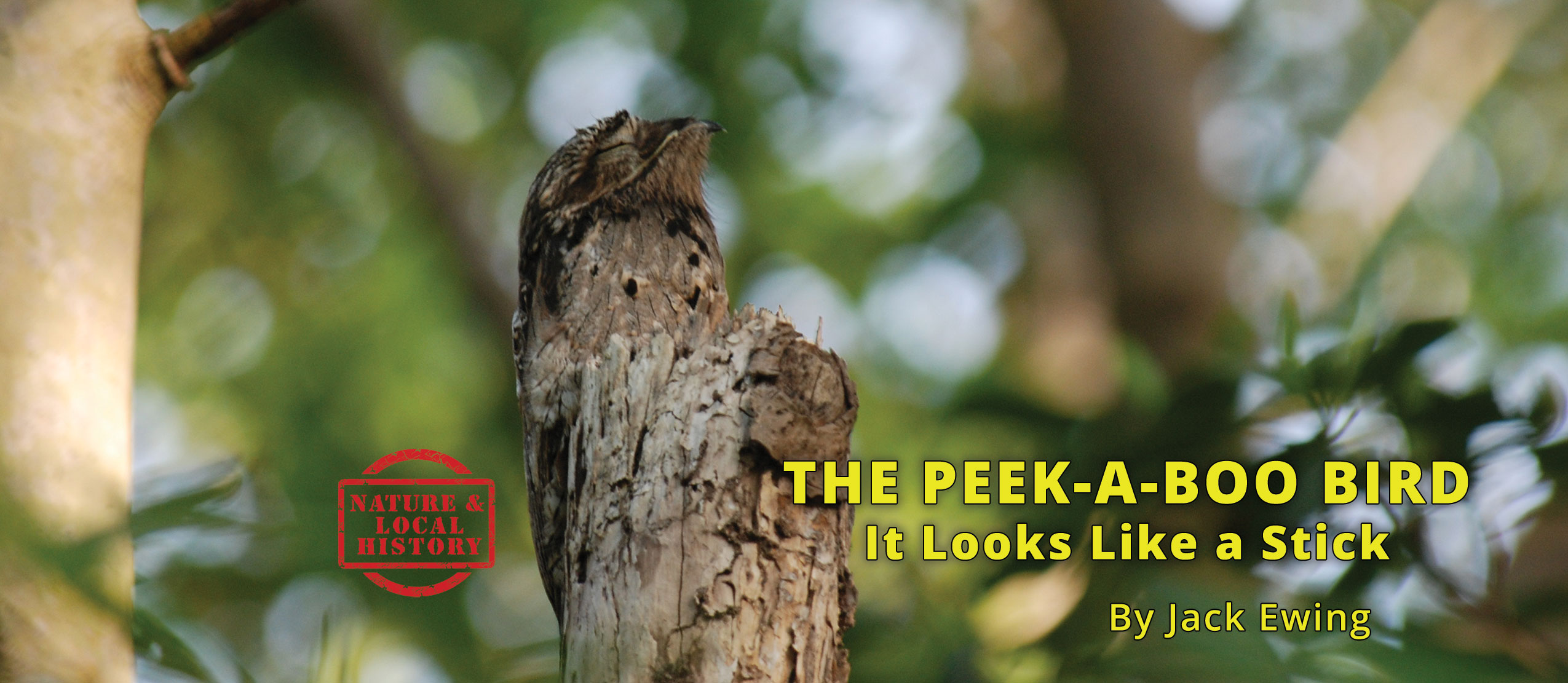The Peek-A-Boo Bird
“Daddy, I’m afraid. I heard a ghost out there”.
“No honey, Orlando told me that a sloth makes that moaning sound”.
Later several other friends and neighbors who had lived their entire lives on or near Hacienda Barú confirmed that the eerie wail we sometimes heard once darkness settled over the area was a sloth. I have a great deal of respect for “campesinos” or country people. They have lived their entire lives in rural or jungle areas, know the wildlife well, and are usually right when explaining about nature. This time, however, they got it wrong.
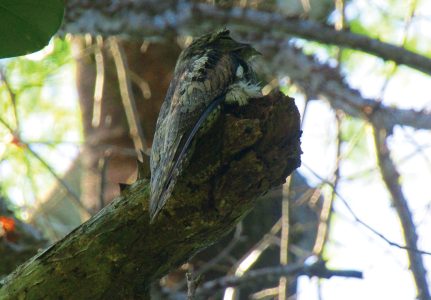 It was at least ten years before I learned the truth. It happened one moonlit night while guiding a group of visitors across a lightly wooded area. At the very top of a fence post sat a bright, round, yellow reflection with a large black dot in the center, obviously a bird’s or animal’s eye. One of the guests was an excellent birder. Briefly illuminating it with a headlamp he quickly identified the bird as a Common Potoo (Nyctibius griseus). “It is one of the best-camouflaged birds in the world”. He told us. No sooner had those words been spoken than the same eerie wail that had frightened my daughter so many years previously emanated from the bird perched atop the post. Now I knew first-hand the source of the sound. A brown-throated three-toed sloth does make a wail somewhat similar to that of the Potoo from time to time, but not necessarily at night, and the sloth’s sound is more like a whistle than a wail.
It was at least ten years before I learned the truth. It happened one moonlit night while guiding a group of visitors across a lightly wooded area. At the very top of a fence post sat a bright, round, yellow reflection with a large black dot in the center, obviously a bird’s or animal’s eye. One of the guests was an excellent birder. Briefly illuminating it with a headlamp he quickly identified the bird as a Common Potoo (Nyctibius griseus). “It is one of the best-camouflaged birds in the world”. He told us. No sooner had those words been spoken than the same eerie wail that had frightened my daughter so many years previously emanated from the bird perched atop the post. Now I knew first-hand the source of the sound. A brown-throated three-toed sloth does make a wail somewhat similar to that of the Potoo from time to time, but not necessarily at night, and the sloth’s sound is more like a whistle than a wail.
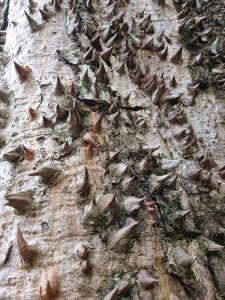 The birder also informed us that the Common Potoo usually perches on the end of a stick and during daylight its color pattern is such that only with great difficulty can you determine where the stick ends and the bird begins. They are so well camouflaged that many people who live in this area, don’t know that they exist.
The birder also informed us that the Common Potoo usually perches on the end of a stick and during daylight its color pattern is such that only with great difficulty can you determine where the stick ends and the bird begins. They are so well camouflaged that many people who live in this area, don’t know that they exist.
Spiny cedar trees have big, thick, sharp spines on the trunk and the branches. During the dry season, the branches become brittle and often break on a windy day. Common Potoos look for the stubs that remain when one of the vertical limbs snaps and hunt for one with a depression on the end where an egg can rest without danger of rolling off. It was in a thicket of spiny cedar trees that I was destined to see my second stick bird. This one was incubating an egg. There is no difference in appearance between the sexes, but it is known that they share the task of sitting on the egg, and once the chick hatches, they take turns protecting the white fluffy youngster. While one is babysitting, the other is hunting large insects which it will chew, swallow, partially digest, and regurgitate into the hungry chick’s wide open mouth.
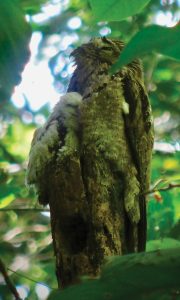 The broken end of the branch where the parent and chick were perched was high enough that I couldn’t get a good photo. The angle was too steep. However, there was another spiny cedar tree nearby that I could climb to the same level as the birds and get an excellent photo. At Hacienda Barú we offered tree climbing tours using strong ropes, devices called ascenders, and applying rock climbing techniques. I was quite good at it; good enough that I decided I could climb a trunk heavily laden with spines. I managed to toss an old climbing rope over a crotch about ten meters (33 feet) above the ground, wore my oldest boots with thick toes, and some heavy gloves, and climbed to the height of the Common Potoo parent and chick in the neighboring tree. I took a whole roll of film that first climb and more on subsequent climbs. The guides at Hacienda Barú have gotten so good at sighting Common Potoos that they find one or two every year. Many are located where it is easy to get photos, and today’s cameras are far superior to the one I used in the spiny cedar grove 30 years ago.
The broken end of the branch where the parent and chick were perched was high enough that I couldn’t get a good photo. The angle was too steep. However, there was another spiny cedar tree nearby that I could climb to the same level as the birds and get an excellent photo. At Hacienda Barú we offered tree climbing tours using strong ropes, devices called ascenders, and applying rock climbing techniques. I was quite good at it; good enough that I decided I could climb a trunk heavily laden with spines. I managed to toss an old climbing rope over a crotch about ten meters (33 feet) above the ground, wore my oldest boots with thick toes, and some heavy gloves, and climbed to the height of the Common Potoo parent and chick in the neighboring tree. I took a whole roll of film that first climb and more on subsequent climbs. The guides at Hacienda Barú have gotten so good at sighting Common Potoos that they find one or two every year. Many are located where it is easy to get photos, and today’s cameras are far superior to the one I used in the spiny cedar grove 30 years ago.
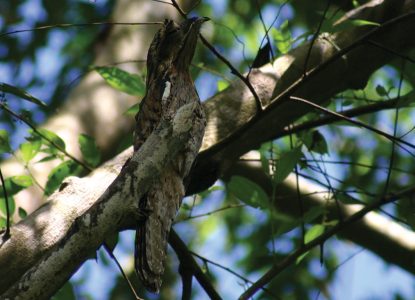 In the photos that accompany this article, it looks like all of the Potoos’ eyes are closed and the birds are asleep. In reality, they are catching glimpses of you from between their lower and upper eyelids, each of which has two or three tiny notches in them. Even with its eyes tightly closed the Common Potoo is peeking at you through the notches and knows every move you make.
In the photos that accompany this article, it looks like all of the Potoos’ eyes are closed and the birds are asleep. In reality, they are catching glimpses of you from between their lower and upper eyelids, each of which has two or three tiny notches in them. Even with its eyes tightly closed the Common Potoo is peeking at you through the notches and knows every move you make.
So many years ago, when my daughter thought the Common Potoo’s wail was a ghost, she had plenty of fellow sympathizers. At many rural locations throughout its range, the bird is often called pájaro fantasma, meaning “ghost bird”. The reason given by most sources is that the species is surrounded by numerous legends.
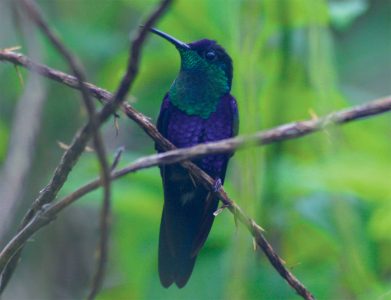 Jack Ewing was born and educated in Colorado. In 1970 he and his wife Diane moved to the jungles of Costa Rica where they raised two children, Natalie and Chris. A newfound fascination with the rainforest was responsible for his transformation from cattle rancher into environmentalist and naturalist. His many years of living in the rainforest have rendered a multitude of personal experiences, many of which are recounted in his published collection of essays, Monkeys are Made of Chocolate. His latest book is, Where Jaguars & Tapirs Once Roamed: Ever-evolving Costa Rica.
Jack Ewing was born and educated in Colorado. In 1970 he and his wife Diane moved to the jungles of Costa Rica where they raised two children, Natalie and Chris. A newfound fascination with the rainforest was responsible for his transformation from cattle rancher into environmentalist and naturalist. His many years of living in the rainforest have rendered a multitude of personal experiences, many of which are recounted in his published collection of essays, Monkeys are Made of Chocolate. His latest book is, Where Jaguars & Tapirs Once Roamed: Ever-evolving Costa Rica.

